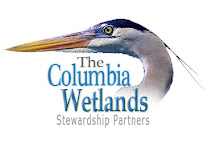Saturday, May 4, 2013
Friday, May 3, 2013
Columbia Spotted Frog Eggs
 |
Columbia Spotted Frog egg mass in the Columbia Valley near Brisco - by Larry Halverson
|
 |
Hatchlings on top of egg mass by Larry Halverson
Females lay eggs in communal masses at the water surface, either freely floating or loosely tangled around emergent vegetation. You can tell that these eggs just hatched because the tadpoles have no eyes and the gills are visible. The hatchling stage of clinging to the egg mass only last a day or two before they become tadpoles.
Water temperature was 22 degrees C which likely why the hatching is earlier in the Columbia Valley than Kootenay National Park where the water temp was 0 degrees C on May 1.
|
Monday, April 29, 2013
Compton Tortoiseshell - An Early Flyer
 |
| Compton Tortoiseshell - April 28, 2013 by Larry Halverson |
Compton Tortoiseshells overwinter as adults so they are one of the earliest butterflies seen each spring. However, they won’t be flying too much longer as they’ll soon lay eggs and die. Look for them along stream sides and clearings particularly where birch, willows and aspen are growing.
If you miss them, there will be another flight from late July until they enter hibernation in October.
Tuesday, April 23, 2013
Wednesday, April 17, 2013
Prevent the Pathway!
 |
| Look at the following picture and identify 10 ways in which Aquatic nuisance species are introduced or spread into local aquatic ecosystems. |
Aquatic nuisance species (ANS) can come from any country in the world and may be introduced into new ecosystems in a variety of ways. The means and routes by which ANS are introduced into an aquatic ecosystem are called introduction pathways. Some species migrate into new areas on their own (volitional movement), while others may be carried into new areas by natural events such as hurricanes or floods. The vast majority of invasive species are spread into new water bodies as a direct result of human activities. Whether intentionally or by accident, once an ANS is introduced and becomes established in a new ecosystem, it is very costly and difficult to control or eradicate them. Often the best approach to preventing the introduction or further spread of ANS is to educate the public on the potential pathways of introduction and steps each person can take to stop the spread of ANS in their local community.
From The Dish on Fish http://fish-notes.blogspot.ca/2013/03/prevent-pathway.html
Subscribe to:
Comments (Atom)


